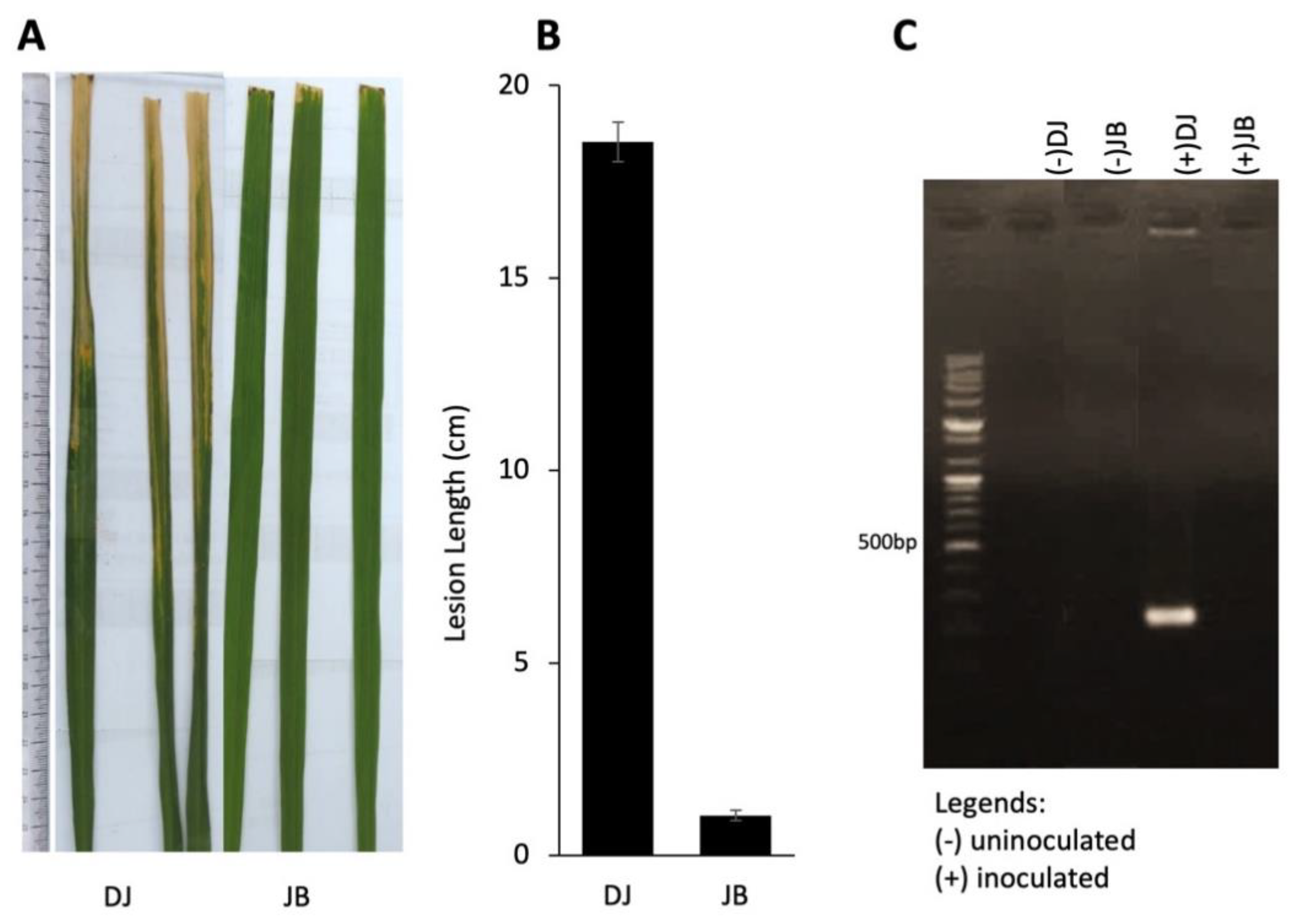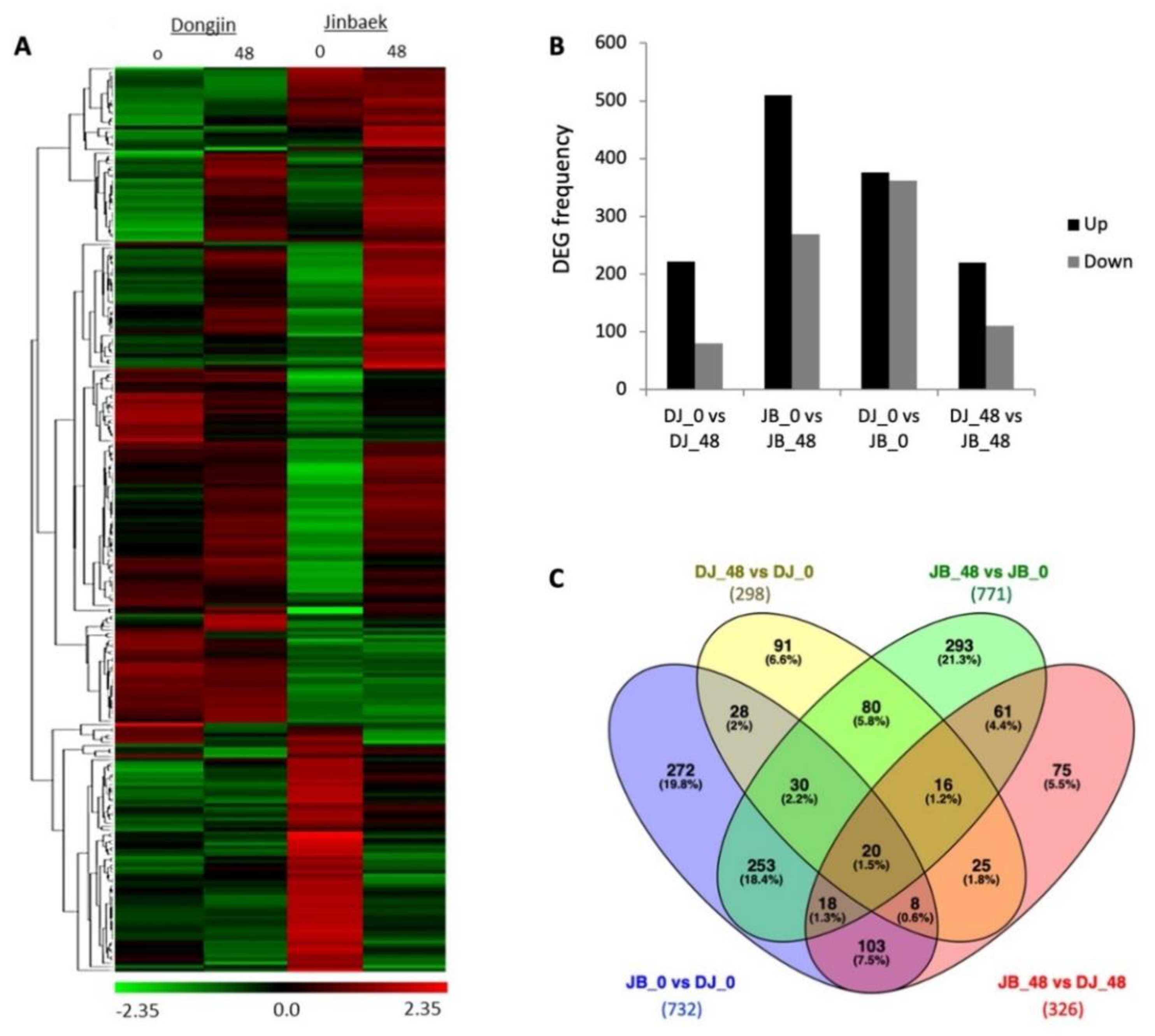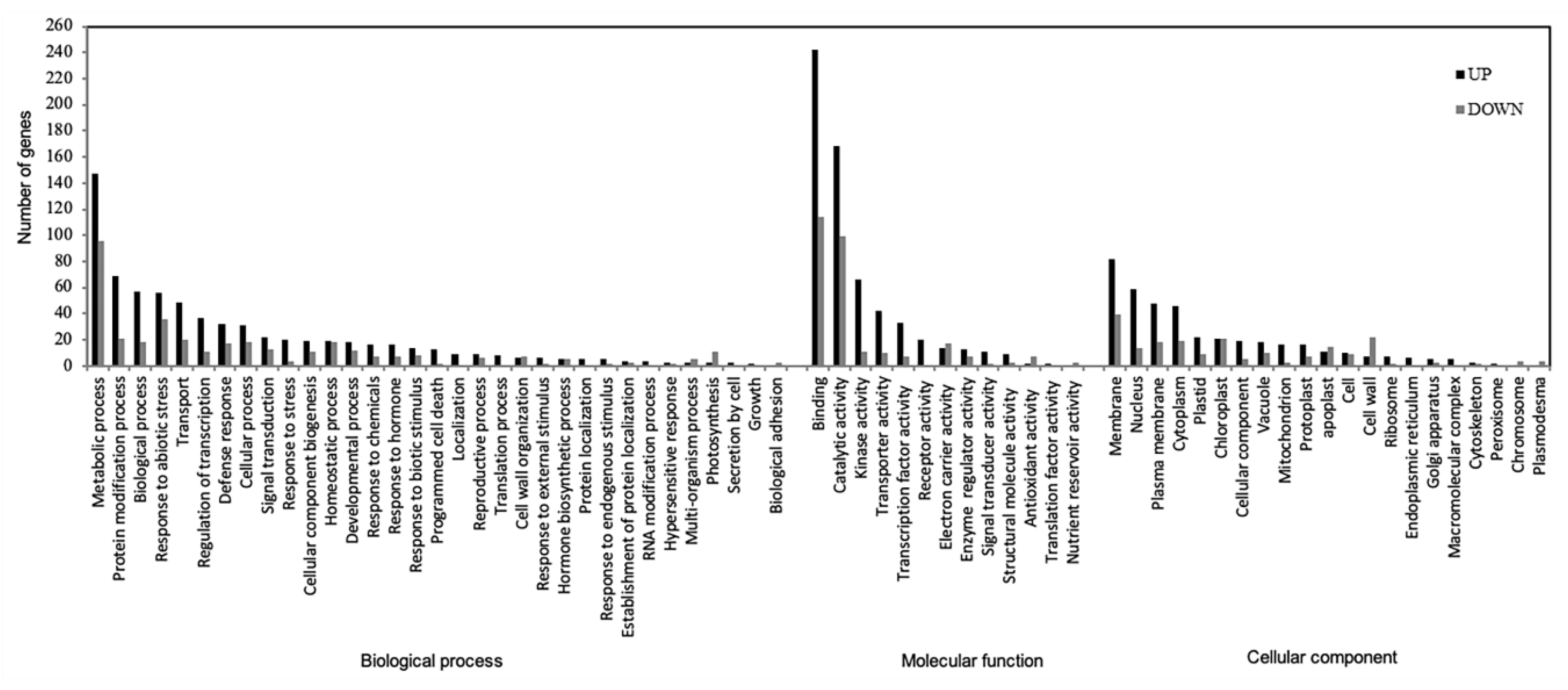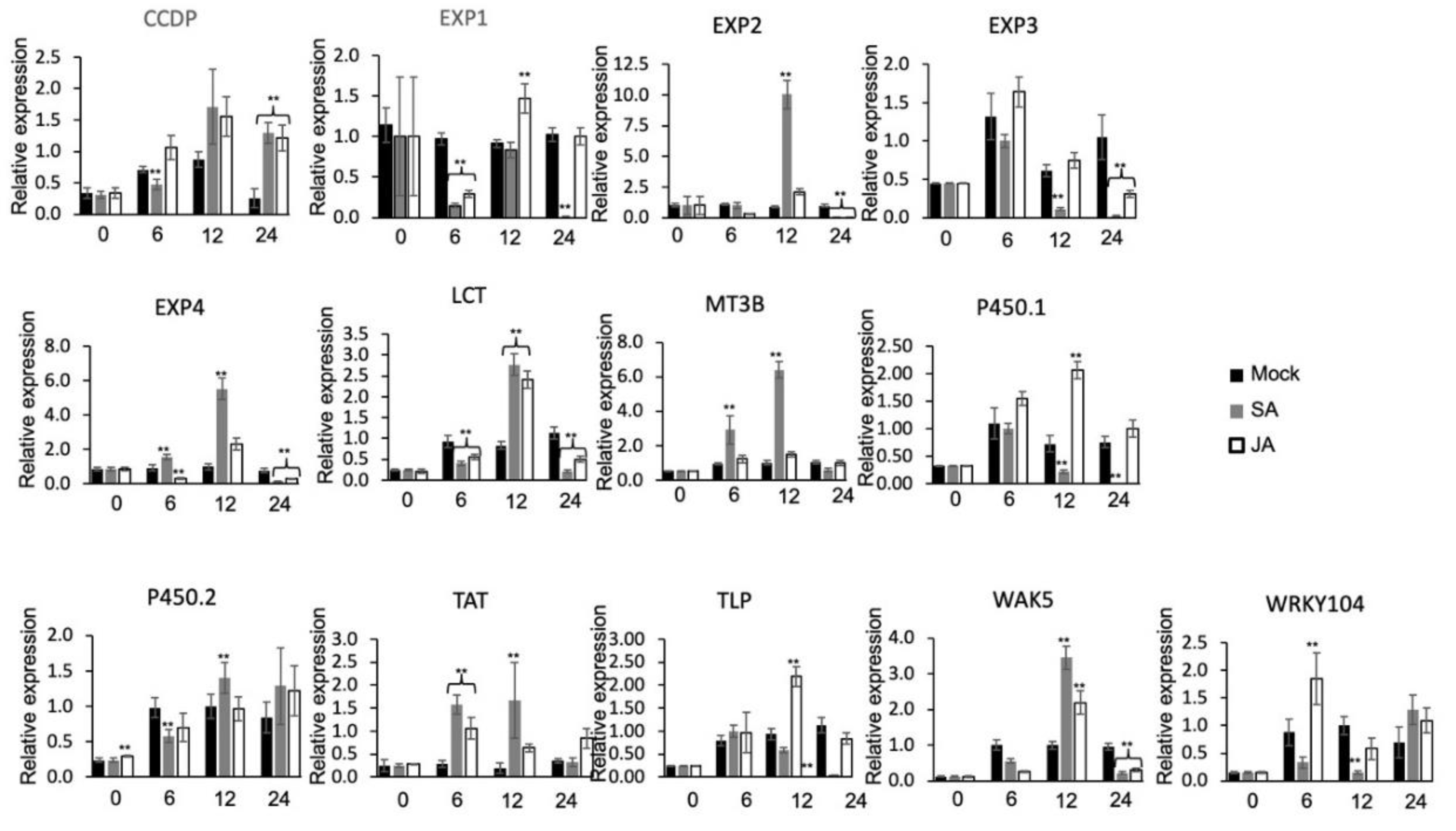Transcriptional Modulation of Resistance against Xanthomonas oryzae pv. oryzae Korean Race K2 in japonica Rice
Abstract
1. Introduction
2. Materials and Methods
2.1. Plant Materials, Growth Conditions, and Treatments
2.2. Molecular Detection of X. oryzae pv. oryzae
2.3. RNA Isolation, cDNA Synthesis, and Hybridization
2.4. Microarray Data Normalization, Analysis, and Gene Annotation
2.5. Expression Analysis of K2-Induced DEGs
2.6. DEGs Isolation, Vector Construction, and Rice Transformation
2.7. Copy Number Assay Using TaqMan qPCR
2.8. Pathogenicity Test
2.9. Statistical Analysis
3. Results
3.1. Phenotypic and Genotypic Characteristics of Dongjin and Jinbaek
3.2. Differentially Expressed Genes between JB and DJ in Response to Xoo K2
3.3. Essential Genes in Key Biological Processes
3.4. Selection of DEGs for Cloning, Ectopic Expression, and Validation
3.5. Generation of Overexpression Transgenic Plants
3.6. Spatio-Temporal Expression of K2-DEGs in Wild Type Rice
3.7. Exogenous Application of SA and JA Induces mRNA Expression of K2-DEGs
3.8. Overexpression of Xoo K2-Induced DEGs Delayed Bacterial Blight Disease Progress
4. Discussion
Supplementary Materials
Author Contributions
Funding
Conflicts of Interest
References
- Rajarajeswari, N.V.L.; Muralidharan, K. Assessments of farm yield and district production loss from bacterial leaf blight epidemics in rice. Crop Prot. 2006, 25, 244–252. [Google Scholar] [CrossRef]
- Kumar, A.; Guha, A.; Bimolata, W.; Reddy, A.R.; Laha, G.S.; Pandey, M.K.; Ghazi, I.A. Leaf gas exchange physiology in rice genotypes infected with bacterial blight: An attempt to link photosynthesis with disease severity and rice yield. AJCS 2013, 7, 32–39. [Google Scholar]
- Khan, M.A.; Naeem, M.; Iqbal, M. Breeding approaches for bacterial leaf blight resistance in rice (Oryza sativa L.), current status and future directions. Eur. J. Plant Pathol. 2014, 139, 27–37. [Google Scholar] [CrossRef]
- Zhang, F.; Zhuo, D.-L.; Zhang, F.; Huang, L.-Y.; Wang, W.-S.; Xu, J.-L.; Vera Cruz, C.; Li, Z.-K.; Zhou, Y.-L. Xa39, a novel dominant gene conferring broad-spectrum resistance to Xanthomonas oryzae pv. oryzae in rice. Plant Pathol. 2015, 64, 568–575. [Google Scholar] [CrossRef]
- Dossa, G.S.; Sparks, A.; Cruz, C.V.; Oliva, R. Decision tools for bacterial blight resistance gene deployment in rice-based agricultural ecosystems. Front. Plant Sci. 2015, 6, 305. [Google Scholar] [CrossRef]
- Huang, N.; Angeles, E.R.; Domingo, J.; Magpantay, G.; Singh, S.; Zhang, G.; Kumaravadivel, N.; Bennett, J.; Khush, G.S. Pyramiding of bacterial blight resistance genes in rice: Marker-assisted selection using RFLP and PCR. Theory Appl. Genet 1997, 95, 313–320. [Google Scholar] [CrossRef]
- Mew, T.W.; Vera Cruz, C.M.; Medella, E.S. Change in race frequency of Xanthomonas oryzae pv. oryzae in response to the planting of rice cultivars in the Philippines. Plant Dis. 1992, 76, 1029–1032. [Google Scholar] [CrossRef]
- Jeung, J.U.; Heu, S.G.; Shin, M.S.; Vera Cruz, C.M.; Jena, K.K. Dynamics of Xanthomonas oryzae pv. oryzae Populations in Korea and Their Relationship to Known Bacterial Blight Resistance Genes. Phytopathology 2006, 96, 867–875. [Google Scholar] [CrossRef] [PubMed]
- Noh, T.H.; Lee, D.K.; Kang, M.H.; Shin, M.S.; Na, S.Y. Identification of new race of Xanthomonas oryzae pv. oryzae (Xoo) in Korea. (Abstr.). Phytopathology 2003, 93, S66. [Google Scholar]
- Kim, K.Y.; Shin, M.S.; Kim, W.J.; Mo, Y.J.; Nam, J.K.; Noh, T.H.; Kim, B.K.; Ko, J.K. Effective combination of resistance genes against rice bacterial blight pathogen. Korean J. Breed Sci. 2009, 41, 244–251. [Google Scholar]
- Suh, J.-P.; Jeung, J.-U.; Noh, T.-H.; Cho, Y.-C.; Park, S.-H.; Park, H.-S.; Shin, M.-S.; Kim, C.-K.; Jena, K.K. Development of breeding lines with three pyramided resistance genes that confer broad-spectrum bacterial blight resistance and their molecular analysis in rice. Rice 2013, 6, 5. [Google Scholar] [CrossRef] [PubMed]
- Lee, B.-M. The genome sequence of Xanthomonas oryzae pathovar oryzae KACC10331, the bacterial blight pathogen of rice. Nucleic Acids Res. 2005, 33, 577–586. [Google Scholar] [CrossRef] [PubMed]
- Iyer-Pascuzzi, A.S.; McCouch, S.R. Recessive Resistance Genes and the Oryza sativa-Xanthomonas oryzae pv. oryzae Pathosystem. MPMI 2007, 20, 731–739. [Google Scholar] [CrossRef] [PubMed][Green Version]
- Narsai, R.; Wang, C.; Chen, J.; Wu, J.; Shou, H.; Whelan, J. Antagonistic, overlapping and distinct responses to biotic stress in rice (Oryza sativa) and interactions with abiotic stress. BMC Genom. 2013, 14, 93. [Google Scholar] [CrossRef] [PubMed]
- Tang, D.; Wang, G.; Zhou, J.M. Receptor Kinases in Plant-Pathogen Interactions: More Than Pattern Recognition. Plant Cell 2017, 29, 618–637. [Google Scholar] [CrossRef] [PubMed]
- Hulbert, S.H.; Webb, C.A.; Smith, S.M.; Sun, Q. Resistance gene complexes: Evolution and utilization. Annu. Rev. Phytopathol. 2001, 39, 285–312. [Google Scholar] [CrossRef]
- Mittler, R.; Blumwald, E. Genetic Engineering for Modern Agriculture: Challenges and Perspectives. Annu. Rev. Plant Biol. 2010, 61, 443–462. [Google Scholar] [CrossRef]
- Stoughton, R.B. Applications of DNA microarrays in biology. Annu. Rev. Biochem. 2005, 74, 53–82. [Google Scholar] [CrossRef]
- Glazebrook, J. Use of Microarray Analysis to Dissect the Plant Defense Response. In Plant-Pathogen Interactions; Humana Press: Totowa, NJ, USA, 2006; Volume 354, pp. 121–130. ISBN 978-1-59259-966-0. [Google Scholar]
- Kikuchi, S. Collection, Mapping, and Annotation of over 28,000 cDNA Clones from japonica Rice. Science 2003, 301, 376–379. [Google Scholar] [CrossRef]
- Lu, W.; Pan, L.; Zhao, H.; Jia, Y.; Wang, Y.; Yu, X.; Wang, X. Molecular detection of Xanthomonas oryzae pv. oryzae, Xanthomonas oryzae pv. oryzicola, and Burkholderia glumae in infected rice seeds and leaves. Crop J. 2014, 2, 398–406. [Google Scholar] [CrossRef]
- Kim, M.S.; Ouk, S.; Jung, K.H.; Song, Y.H.; Trang, L.V.; Yang, J.Y.; Cho, Y.G. Breeding hybrid rice with genes resistant to diseases and insects using marker-assisted selection and evaluation of biological assay. Plant Breed. Biotech. 2019, 7, 272–286. [Google Scholar] [CrossRef]
- Huang, D.W.; Sherman, B.T.; Lempicki, R.A. Systematic and integrative analysis of large gene lists using DAVID bioinformatics resources. Nat. Protoc. 2009, 4, 44–57. [Google Scholar] [CrossRef]
- Lee, H.J.; Abdula, S.E.; Jee, M.G.; Jang, D.W.; Cho, Y.G. High-efficiency and Rapid Agrobacterium-mediated genetic transformation method using germinating rice seeds. J. Plant Biotechnol. 2011, 38, 251–257. [Google Scholar] [CrossRef]
- Kauffman, H.; Reddy, A.; Hsieh, S.; Merca, S. Improved technique for evaluating resistance of rice varieties to Xanthomonas oryzae. Plant Dis. Rep. 1973, 57, 537–541. [Google Scholar]
- IRRI. Standard Evaluation System for Rice, 4th ed.; International Rice Testing Program (IRRI): Manila, Philippines, 1996; 52p. [Google Scholar]
- Vaid, N.; Macovei, A.; Tuteja, N. Knights in Action: Lectin Receptor-Like Kinases in Plant Development and Stress Responses. Mol. Plant 2013, 6, 1405–1418. [Google Scholar] [CrossRef]
- Gómez-Gómez, L.; Boller, T. Flagellin perception: A paradigm for innate immunity. Trends Plant Sci. 2002, 7, 251–256. [Google Scholar]
- Goff, K.E.; Ramonell, K.M. The Role and Regulation of Receptor-Like Kinases in Plant Defense. Gene Regul. Syst. Bio. 2007, 1, 117762500700100. [Google Scholar] [CrossRef]
- González-Lamothe, R.; Tsitsigiannis, D.I.; Ludwig, A.A.; Panicot, M.; Shirasu, K.; Jones, J.D.G. The U-Box Protein CMPG1 Is Required for Efficient Activation of Defense Mechanisms Triggered by Multiple Resistance Genes in Tobacco and Tomato. Plant Cell 2006, 18, 1067–1083. [Google Scholar] [CrossRef]
- Mulligan, R.M.; Chory, J.; Ecker, J.R. Signaling in plants. Proc. Natl. Acad. Sci. USA. 1997, 94, 2793–2795. [Google Scholar] [CrossRef] [PubMed]
- Grant, M.; Brown, I.; Adams, S.; Knight, M.; Ainslie, A.; Mans, J. The RPM1 plant disease resistance gene facilitates a rapid and sustained increase in cytosolic calcium that is necessary for the oxidative burst and hypersensitive cell death. Plant J. 2000, 10. [Google Scholar] [CrossRef]
- Liu, J.; Ishitani, M.; Halfter, U.; Kim, C.-S.; Zhu, J.-K. The Arabidopsis thaliana SOS2 gene encodes a protein kinase that is required for salt tolerance. Plant Biol. 2000, 97, 3730–3734. [Google Scholar] [CrossRef]
- Pandey, G.K.; Kanwar, P.; Singh, A.; Steinhorst, L.; Pandey, A.; Yadav, A.K.; Tokas, I.; Sanyal, S.K.; Kim, B.-G.; Lee, S.-C.; et al. Calcineurin B-Like Protein-Interacting Protein Kinase CIPK21 Regulates Osmotic and Salt Stress Responses in Arabidopsis. Plant Physiol. 2015, 169, 780–792. [Google Scholar] [CrossRef] [PubMed]
- Kurusu, T.; Hamada, J.; Hamada, H.; Hanamata, S.; Kuchitsu, K. Roles of calcineurin B-like protein-interacting protein kinases in innate immunity in rice. Plant Signal. Behav. 2010, 5, 1045–1047. [Google Scholar] [CrossRef] [PubMed]
- Cheng, M.-C.; Liao, P.-M.; Kuo, W.-W.; Lin, T.-P. The Arabidopsis ETHYLENE RESPONSE FACTOR1 Regulates Abiotic Stress-Responsive Gene Expression by Binding to Different cis-Acting Elements in Response to Different Stress Signals. Plant Physiol. 2013, 162, 1566–1582. [Google Scholar] [CrossRef] [PubMed]
- Xiong, L.; Yang, Y. Disease Resistance and Abiotic Stress Tolerance in Rice Are Inversely Modulated by an Abscisic Acid–Inducible Mitogen-Activated Protein Kinase. Plant Cell 2003, 15, 745–759. [Google Scholar] [CrossRef]
- Durian, G.; Rahikainen, M.; Alegre, S.; Brosché, M.; Kangasjärvi, S. Protein Phosphatase 2A in the Regulatory Network Underlying Biotic Stress Resistance in Plants. Front. Plant Sci. 2016, 7. [Google Scholar] [CrossRef] [PubMed]
- Liu, X.; Bai, X.; Wang, X.; Chu, C. OsWRKY71, a rice transcription factor, is involved in rice defense response. J. Plant Physiol. 2007, 164, 969–979. [Google Scholar] [CrossRef]
- Fukushima, S.; Mori, M.; Sugano, S.; Takatsuji, H. Transcription Factor WRKY62 Plays a Role in Pathogen Defense and Hypoxia-Responsive Gene Expression in Rice. Plant Cell Physiol 2016, 57, 2541–2551. [Google Scholar] [CrossRef]
- Rahman, T.A.E.; Oirdi, M.E.; Gonzalez-Lamothe, R.; Bouarab, K. Necrotrophic Pathogens Use the Salicylic Acid Signaling Pathway to Promote Disease Development in Tomato. MPMI 2012, 25, 1584–1593. [Google Scholar] [CrossRef]
- Niemeyer, H.M. Hydroxamic acids (4-hydroxy-1,4- benzoxazin-3-ones), defense chemicals in the gramineae. Phytochemistry. 1988, 27, 3349–3358. [Google Scholar] [CrossRef]
- Geisler, K.; Hughes, R.K.; Sainsbury, F.; Lomonossoff, G.P.; Rejzek, M.; Fairhurst, S.; Olsen, C.-E.; Motawia, M.S.; Melton, R.E.; Hemmings, A.M.; et al. Biochemical analysis of a multifunctional cytochrome P450 (CYP51) enzyme required for synthesis of antimicrobial triterpenes in plants. Proc. Natl. Acad. Sci. USA 2013, 110, E3360–E3367. [Google Scholar] [CrossRef] [PubMed]








| Enriched Term | Enrichment | p-Value | Count | % | List Total |
|---|---|---|---|---|---|
| Transcription factor activity | 9.57 | 3.34 × 10−7 | 36 | 6.2827 | 329 |
| Integral component of membrane | 2.62 | 0.01756 | 116 | 20.2443 | 306 |
| Response to bacterium | 2.41 | 0.00311 | 3 | 0.5236 | 229 |
| Regulation of defense response | 2.26 | 0.00148 | 5 | 0.8726 | 229 |
| Plant hormone signal transduction | 2.26 | 0.10285 | 7 | 1.2216 | 71 |
| Chitin catabolic process | 2.13 | 7.04 × 10−5 | 8 | 1.3962 | 229 |
| Signal peptide | 2.13 | 0.01082 | 17 | 2.9668 | 58 |
| Protein kinase, ATP binding site | 1.85 | 8.15 × 10−4 | 32 | 5.5846 | 434 |
| Cytochrome P450, conserved site | 1.80 | 9.46 × 10−4 | 15 | 2.6178 | 434 |
| Secondary metabolites biosynthesis | 1.80 | 0.015962 | 15 | 2.6178 | 57 |
| Differentiation | 1.28 | 0.008475 | 5 | 0.8726 | 447 |
| Signal transduction | 1.04 | 0.022859 | 7 | 1.2216 | 229 |
| Locus | Gene | Expression Pattern | |||
|---|---|---|---|---|---|
| Microarray | qRT-PCR | ||||
| Exp. Pattern | F.C. | Exp. Pattern | F.C. | ||
| LOC_Os05g11320.1 | metallothionein-like protein 3B (MT3B) | Up | 76.2 | Up | 25.51 ± 0.92 |
| NM_001069356 | expressed protein (EXP1) | Up | 54.18 | Up | 363.97 ± 9.86 |
| LOC_Os08g26230.4 | expressed protein (EXP2) | Up | 20.45 | Up | 53.53 ± 1.80 |
| LOC_Os01g36294.1 | cytochrome P450 (P450.1) | Up | 15.92 | Up | 75.40 ± 4.03 |
| LOC_Os06g38120.1 | low-affinity cation transporter (LCT) | Up | 15.82 | Up | 15.91 ± 0.31 |
| LOC_Os12g43380.1 | thaumatin (TLP) | Up | 12.56 | Up | 10.70 ± 0.93 |
| NM_001189913 | expressed protein (EXP3) | Up | 12.16 | Up | 92.19 ± 5.66 |
| LOC_Os04g30250.3 | wall-associated receptor kinase-like 5 precursor (WAK5) | Up | 11.9 | Up | 31.74 ± 2.79 |
| LOC_Os09g10340.1 | cytochrome P450 (P450.2) | Up | 11.69 | Up | 8.32 ± 0.18 |
| AK062654 | cortical cell delineating protein precursor (CCDP) | Up | 10.93 | Up | 38.89 ± 1.76 |
| LOC_Os11g02520.1 | WRKY104 transcription factor (WRKY104) | Up | 10.9 | Up | 26.43 ± 1.25 |
| LOC_Os09g04310.1 | expressed protein (EXP4) | Up | 10.78 | Up | 32.43 ± 1.81 |
| LOC_Os01g45640 | twin-arginine translocation pathway signal (TAT) | Up | 10.1 | Up | 9.6 ± o.51 |
| Transgenic Rice | Gene ID | No. of Plants with Single Copy Gene | Calculated Copy Number (Range) |
|---|---|---|---|
| MT3B | LOC_Os05g11320.1 | 6 | 1.37 ± 0.08 to 1.44 ± 0.03 |
| EXP1 | NM_001069356 | 4 | 0.87 ± 0.05 to 1.25 ± 0.03 |
| EXP2 | LOC_Os08g26230.4 | 16 | 1.27 ± 0.05 to 1.47 ± 0.01 |
| P450.1 | LOC_Os01g36294.1 | 11 | 1.17 ± 0.04 to 1.31 ± 0.07 |
| LCT | LOC_Os06g38120.1 | 9 | 0.82 ± 0.10 to 1.44 ± 0.03 |
| TLP | LOC_Os12g43380.1 | 16 | 1.17 ± 0.01 to 1.49 ± 0.01 |
| EXP3 | NM_001189913 | 10 | 0.91 ± 0.03 to 1.48 ± 0.11 |
| WAK5 | LOC_Os04g30250.3 | 4 | 0.74 ± 0.30 to 1.38 ± 0.04 |
| P450.2 | LOC_Os09g10340.1 | 14 | 1.04 ± 0.13 to 1.39 ± 0.05 |
| CCDP | AK062654 | 13 | 1.19 ± 0.01 to 1.30 ± 0.09 |
| WRKY104 | LOC_Os11g02520.1 | 16 | 0.57 ± 0.04 to 1.24 ± 0.62 |
| EXP4 | LOC_Os09g04310.1 | 9 | 1.12 ± 0.10 to 1.42 ± 0.07 |
| TAT | LOC_Os01g45640.1 | 11 | 0.57 ± 0.04 to 1.44 ± 0.09 |
© 2020 by the authors. Licensee MDPI, Basel, Switzerland. This article is an open access article distributed under the terms and conditions of the Creative Commons Attribution (CC BY) license (http://creativecommons.org/licenses/by/4.0/).
Share and Cite
Niño, M.C.; Cho, Y.-G. Transcriptional Modulation of Resistance against Xanthomonas oryzae pv. oryzae Korean Race K2 in japonica Rice. Agronomy 2020, 10, 960. https://doi.org/10.3390/agronomy10070960
Niño MC, Cho Y-G. Transcriptional Modulation of Resistance against Xanthomonas oryzae pv. oryzae Korean Race K2 in japonica Rice. Agronomy. 2020; 10(7):960. https://doi.org/10.3390/agronomy10070960
Chicago/Turabian StyleNiño, Marjohn C., and Yong-Gu Cho. 2020. "Transcriptional Modulation of Resistance against Xanthomonas oryzae pv. oryzae Korean Race K2 in japonica Rice" Agronomy 10, no. 7: 960. https://doi.org/10.3390/agronomy10070960
APA StyleNiño, M. C., & Cho, Y.-G. (2020). Transcriptional Modulation of Resistance against Xanthomonas oryzae pv. oryzae Korean Race K2 in japonica Rice. Agronomy, 10(7), 960. https://doi.org/10.3390/agronomy10070960






